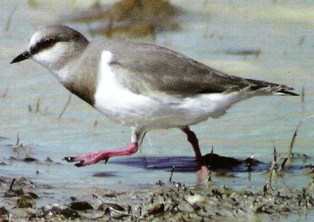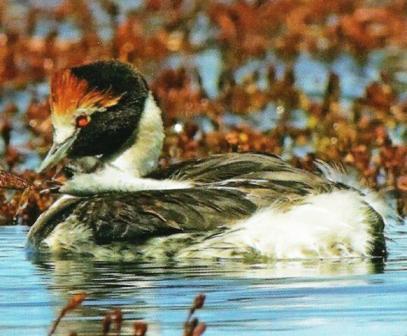Photos with this report (click to enlarge) | |||
 Magellanic Plover |
 Hooded Grebe |
||
Yearly many birders living in the Northern Hemisphere feel curious at visiting and birding in South America, some of them visiting subtropical, tropical and equatorial areas while others venture into the fascinating southern part of the continent known as Patagonia.
Many North American migrating birds, especially waders come to "winter" down south spreading their distribution from the fertile "Pampas" down to "Tierra del Fuego".
In the southern hemisphere, Spring starts in late September yet in southern Patagonia its arrival is felt several months later with most migrating birds arriving in November, with some locals to nest while others just to "winter".
Most visiting birders find little of interest looking at the dull coloured "wintering" migrating North American waders, yet the interest is focused on some local birds that are exclusive Patagonian "specialties".
In Patagonia most of the birding is done along its Atlantic Ocean shores with the "Valdes Peninsula" being its most famous birding destiny, while the other most popular places visited are found in the western woody valleys running in the southern Andes mountains. On the continental part, most visited is the "Glaciers National Park" close to Calafate town with its "Nimes Lagoon" a must to all birders, then the woods and lakes on the "Tierra del Fuego" island starting at Rio Grande ending southwards around Ushuaia.
There are many local birds to be seen, some are elusive and scarce while others are abundant and oblige. Some birders come to look at all the birds they can find while others also seek some "specialties" like the Snowy Sheathbill, Magellanic Woodpecker (nowadays the largest Woodpecker in the world), Magellanic Plover, Hooded Grebe and Austral Rail, all birds that are considered "target birds" among the rest. While bird guiding in Patagonia during the past years, I had the chance of meeting and talking to quite a number of visiting birders that told me how disappointed they were at having visited Southern Patagonia in groups or alone and not having seen most of the mentioned "specialties".
This I told them was mainly due to a bad timing of the trips and a lack of trustful info. The "Snowy Sheathbill" is found along the Patagonian Atlantic shores slowly moving during the Spring outwards, so by New Year a few still can be seen around Ushuaia and the Beagle Channel while later they all move to Antarctica. On the other part, "Magellanic Plovers" start showing up on the shores of Lake Argentino at Calafate around Christmas and later down south to Ushuaia. There shouldn't be any problems at finding and seeing the "Magellanic Woodpecker" together with the "Austral Parakeet" in the woody areas where they are quite common during the Spring - Summer seasons.
If you have a good eye trained at spotting hummingbirds, you might see the "Green-backed Firecrown" zooming and fluttering among bushes and trees seeking flowers, it's the only one found around.
A rare, shy and elusive bird is the "Austral Rail". This bird lives close to marshy places more often in the Patagonian plains area, mostly found in the large sheep farms. To find this bird, birders should arrange a visit to such farms. Some locals say that during early Spring, the "Austral Rail" calls back and comes to the call of the North American "Virginia Rail".
Nowadays seeing the "Hooded Grebe" must be considered like hitting the jackpot. This bird is on the brink of extinction with only about 900 known breeding couples left. Although it winters on the Coyle and Rio Gallegos rivers estuaries on the eastern Atlantic, in late Spring it moves into its upland western breeding areas starting from the Viedma and Cardiel lakes and up into the Strobel Plateau where it builds on fairly small side-lakes and lagoons its typical floating nests. The dramatic downfall of this bird apparently is caused by several predators like "trout" eating its chicks, "Kelp Gulls" attacking nesting adults eating the eggs and chicks and finally, the "mink" that were released into the wilderness by local fur farmers that bred them for the now out of fashion natural fur coats industry.
According to farm hands "Gauchos" I met and consulted during several years, they see the "Hooded Grebe" in the lagoons close to the aforementioned places chasing each other as from around the end of the first week of January. Something to bear in mind when planning a "Patagonian Birds Specialties" sighting trip.